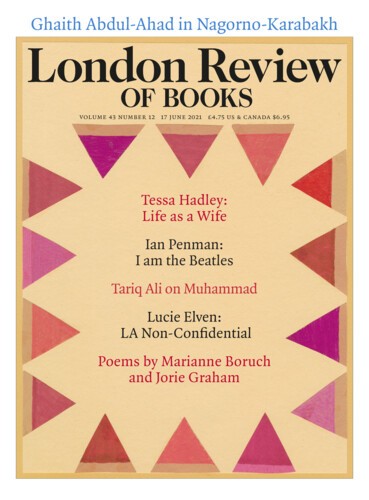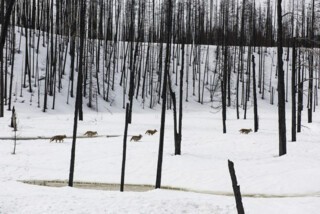Matthew Barney is back. It’s been ten years since his last exhibition in London, and his new show at the Hayward opens with an unapologetic display of phallocentrism. It’s a commitment of long standing. The Cremaster Cycle (1994-2002), the series of films and sculptures that made him famous, took its name from the muscle that regulates the temperature of the testicles. His operatic follow-up, River of Fundament (2014), was not only full of hand jobs, but chose as its ‘host body’ (in Barney vernacular) a novel by Norman Mailer. ‘Crude thoughts and fierce forces are my state,’ as Mailer put it. Redoubt (until 25 July) is as vast in scale as its predecessors, and just as extravagant, but it’s a more contemplative and more elegant affair that hints at an awareness of what it lacks.
The opening work, Cosmic Hunt, is a 13-foot lodgepole pine, half burned in a forest fire, which Barney cast in stainless steel, adding artillery emplacement appendages to raise it to 45 degrees. Its gun-like tip is adorned with 3D-printed wolf fur. The piece is virtuosic and maddeningly kitsch (and made more so by the copper portholes onto the cosmos that surround it). But Barney is never not serious too. The lodgepole, common to the mountainous regions of Idaho, propagates through the action of wildfire: the heat from the fires opens the cones and releases the seeds. Incineration in molten metal is the tree’s second regenerative encounter with fire.
Barney grew up in Idaho’s Sawtooth Mountains and the forested snowscapes of the region provide the epic cinematic centrepiece of Redoubt. His usual instinct to overwhelm the viewer, to dazzle and bewilder us, is replaced here by a clarity of focus. The nearly three-hour-long film is a loose retelling of the Diana and Actaeon myth, starring Barney himself as a Forest Ranger (Actaeon) and Anette Wachter (Diana), a real-life sharpshooter and darling of the NRA, as a hunter on a wolf hunt. The landscape is reminiscent of paintings by the American artist Sanford Robinson Gifford. In his Twilight in the Catskills (1861), burned lodgepole pines symbolise unease at impending civil war. Like Gifford’s impossibly smooth mountain lakes (what genocidal horrors are they hiding?), Redoubt is steeped in, but never directly confronts, a deep social unease. The exhibition’s title is taken from ‘American Redoubt’, the name recently given to wild areas of the Midwest, including Idaho, by survivalists looking to form off-grid communities in the event of civil disintegration (there are now estate agencies set up to cater to this clientele, see www.eaglestar.net). The area is also at the centre of a fierce, decades-long dispute over wolf reintroduction, which has in recent months shifted in favour of the anti-wolf lobby. A bill passed this spring allows contract killers to slaughter 90 per cent of the population.
We follow Wachter, or Diana, on six hunting excursions accompanied by two dancers, who ‘move in concert’. The choreography is contact improvisation, which is to say, dated, laborious and best ignored. Park Ranger Barney spends most of his time making engravings of the landscape en plein air, before visiting the electroplater, who lives in a caravan by the river. The electroplater plunges his engravings into baths of copper sulphate and sulphuric acid; we dive into the fluid too, our vision turns blue, our ears fizz, and the scratched inscriptions start to tumesce like metallic fungi, producing the scorched plates we see later on the gallery walls. The most interesting are those where the copper wiring used to hold the plate in the acid bath has been left on and has reacted with the chemicals. The twists of wire resemble antlers. In their parallel excursions through the landscape, Diana and Actaeon encounter each other numerous times, and the hunter-hunted dialectic rebounds as Actaeon starts to inscribe the image of Diana, before Diana fires bullets sniper-style into the copper plates.
Unlike Titian’s paintings of the story, there is little sense here of an erotic power play between the two protagonists (there’s also no dialogue). What we have is a love letter to process. Barney measures snow, Wachter makes bullets, a wolf is delicately flayed, magpies peck in vain at a frozen carcass, a motion-sensitive camera is set up and then carefully tested, a gun barrel is cleaned. Is it boring? At points. But the film is redeemed by its oddness. We learn that Diana drinks instant coffee while the electroplater prefers a Bialetti moka.
Barney’s overriding concern, however, is with the insurrectionary forces of fire and predator that haunt the exhibition. He seems to be asking the viewer: how close would you let real wildness get to you? Watching the film, the answer seems to be: not close at all. Despite its cosmic, mythological ambition, the effect is one of impotence. The footage of the wolf isn’t red in tooth and claw; the wolves are doggish, even when tearing apart a caravan, as they do at the end. They lack that powerful carnivore gait. This is, of course, because they’re not really wolves, but ‘trained animals … provided by professional handlers’. Like the fires in the film, they are domesticated versions of something uncontainable. Art-making itself starts to look like a process of domestication, embodied in the artist-as-ranger. The wild is way beyond Barney’s grasp.
On the balcony of the Hayward is Sawtooth Battery, a slender ten-metre bronze and copper sculpture, also cast from a lodgepole pine and fixed to the ground by more optical kit. A rope coils down from the top, inviting us to ascend. Inside the gallery, two pines, laid on their side, have been worked to transform them into rifles, complete with wooden handles. A further two reach upwards, pointing to some unseen target. A solar eclipse? Or a wolf’s skull in the crosshairs? Redoubt yearns for the moment when things align.
Barney has never pandered to his crowd; rather, he seems to enjoy provoking them. Casting a prominent NRA advocate as the star of his show is so obviously controversial there’s no point critiquing it. In Drawing Restraint Nine (2005), filmed with his ex-partner Björk onboard the Japanese whaling ship Nisshin Maru, sheer brutality is treated as a fact of life. It’s simply a question of where and in what ways the energy is distributed – and how close you get. But his artful dialectics don’t allow for destruction as destruction. Sometimes there is no ‘rebirth’.
A much smaller exhibition of work by the South African artist Igshaan Adams is on show alongside Redoubt. Kicking Dust occupies a single room: entering it is like walking into the internal chamber of some busy, colourful flower. On the floor and walls are densely hung tapestries that portray linoleum floors worn down by years of footfall. Geometric patterns are disturbed by lichen-like textures, rendered in extraordinarily fine weaves of ribbon, bead, silk and chain. They encircle ultrafine woven sculptures – representations of the clouds of dust left in the air after the Rieldans dance of the Nama people, from whom Adams is descended. It’s a useful counterpoint to Barney’s stargazing, bringing us down to stitched and shimmering earth.
Send Letters To:
The Editor
London Review of Books,
28 Little Russell Street
London, WC1A 2HN
letters@lrb.co.uk
Please include name, address, and a telephone number.


